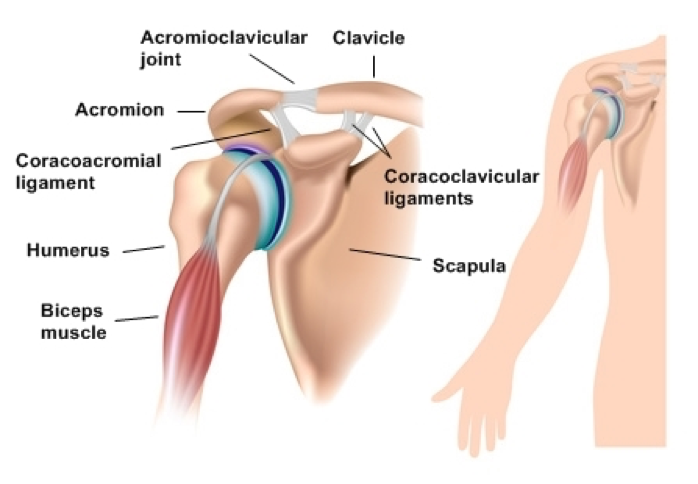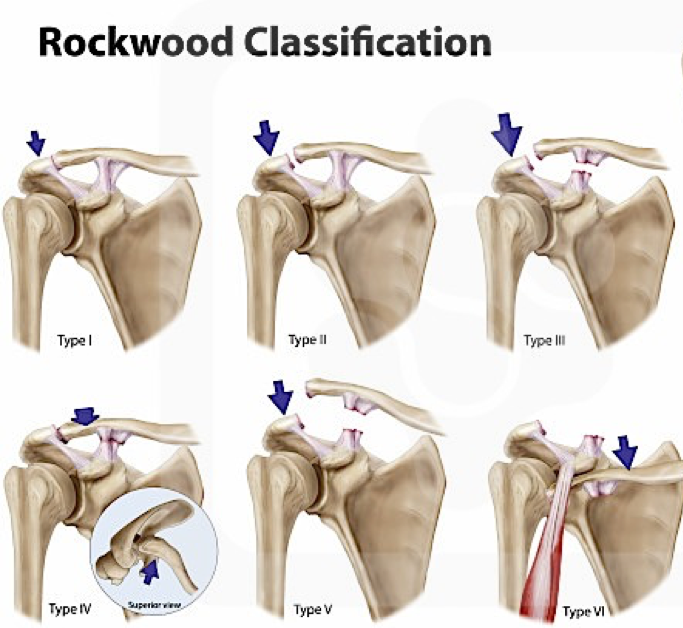Words by Physio Sarah Bombell B.Ex.Sc(Grif), M.Phty(Grif)
The acromioclavicular joint, or AC joint, is the small joint on top of your shoulder where your collar bone attaches. Pain arising from the AC joint can be due to an acute injury, repeated minor injuries, poor biomechanics or degenerative changes. Pathology is most common in athletes involved in contact sports or ‘overhead’ sports like swimming and throwing.
The AC joint is a small joint that basically anchors the shoulder blade (scapula) onto the trunk via the collar bone (clavicle). Its name referring to the bony connection between the acromion (a bony projection off the top of the scapula) and the clavicle. It has limited movement when compared to joints like the shoulder or hip, however it has been described to swing a little, rock a little, twist a little, slide a little and act like a hinge to ensure correct mechanics around the entire shoulder girdle. Like other joints in the body it is supported by ligaments and a joint capsule encasing fluid and a fibrocartilage disc.
Acute injuries
An acute injury of the AC joint occurs due a direct force or fall onto the point of the shoulder or an indirect force like a fall onto the elbow. This force will result in a sprain or tear of the ligaments and or capsule causing separation of the joint. There are various degrees of separation from mild to complete and can result in a “step deformity” of the shoulder. Treatment of acute injuries vary depending on the degree of injury but may include support with tape or a sling, rest, anti-inflammatories or operative stabilisation.
Non-traumatic AC joint pain is generally more difficult to diagnose and is more common than acute traumatic injuries. Non-traumatic pain in the AC joint can occur from repeated low grade sprains, repeated irritation or arthritis of the joint.
Low grade sprains are very common in contact sports like rugby where repeated heavy contact to the shoulder occurs from tackling. Management of this usually involves taping to support the joint, avoiding direct contact with the shoulder (if possible) and may need anti-inflammatories to settle.
Repeated irritation of the AC joint is a common issue that we in clinic. This occurs mostly in those individuals who do a lot of overhead activities like a builder, painter, swimmer, thrower and weightlifter. Repeated irritation will occur due to poor strength, mobility or biomechanics which results in excessive load through the joint. Management of AC joint irritation will involve addressing strength, mobility and technique to deload the joint and allow it to settle.
Arthritis of the AC joint is also quite common especially in older individuals who have a history of an AC joint injury. Management of arthritis of the AC joint will involve activity modification, mobility, strength and correcting shoulder biomechanics. The there is still pain after addressing these factors then injections or surgery may be indicated.
 How do I know if I have hurt my AC joint?
How do I know if I have hurt my AC joint?
If you have had a traumatic injury to the AC joint due to a fall or direct blow it is important to get a scan to determine the extent of the injury and rule out fracture. Those experiencing non-traumatic AC joint pain will be tender to press over the point of the shoulder and have pain with pushing or bringing the arm across the body.
What do I do?
An assessment by a physiotherapist is the best place to start. We are skilled at determining how and why you are experiencing pain and will provide you with exercises and a management plan to overcome the issue.
Sarah Bombell is available for consult at Runaway Bay clinic, bookings 07 5500 6470


